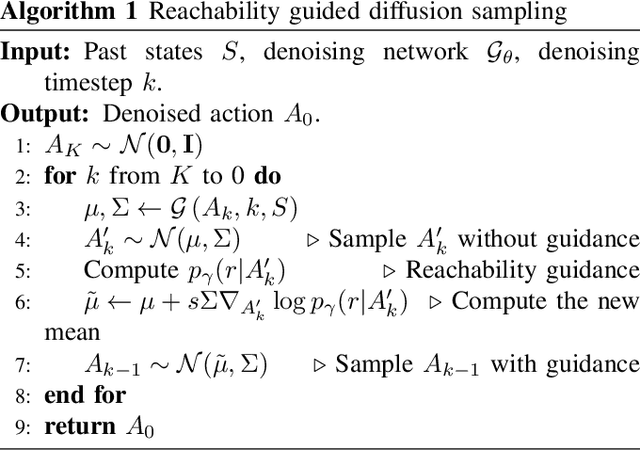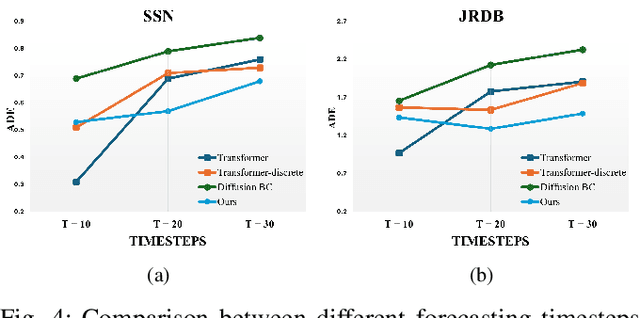Zhitian Zhang
Predicting Long-Term Human Behaviors in Discrete Representations via Physics-Guided Diffusion
May 29, 2024



Abstract:Long-term human trajectory prediction is a challenging yet critical task in robotics and autonomous systems. Prior work that studied how to predict accurate short-term human trajectories with only unimodal features often failed in long-term prediction. Reinforcement learning provides a good solution for learning human long-term behaviors but can suffer from challenges in data efficiency and optimization. In this work, we propose a long-term human trajectory forecasting framework that leverages a guided diffusion model to generate diverse long-term human behaviors in a high-level latent action space, obtained via a hierarchical action quantization scheme using a VQ-VAE to discretize continuous trajectories and the available context. The latent actions are predicted by our guided diffusion model, which uses physics-inspired guidance at test time to constrain generated multimodal action distributions. Specifically, we use reachability analysis during the reverse denoising process to guide the diffusion steps toward physically feasible latent actions. We evaluate our framework on two publicly available human trajectory forecasting datasets: SFU-Store-Nav and JRDB, and extensive experimental results show that our framework achieves superior performance in long-term human trajectory forecasting.
Good Things Come in Trees: Emotion and Context Aware Behaviour Trees for Ethical Robotic Decision-Making
May 10, 2024Abstract:Emotions guide our decision making process and yet have been little explored in practical ethical decision making scenarios. In this challenge, we explore emotions and how they can influence ethical decision making in a home robot context: which fetch requests should a robot execute, and why or why not? We discuss, in particular, two aspects of emotion: (1) somatic markers: objects to be retrieved are tagged as negative (dangerous, e.g. knives or mind-altering, e.g. medicine with overdose potential), providing a quick heuristic for where to focus attention to avoid the classic Frame Problem of artificial intelligence, (2) emotion inference: users' valence and arousal levels are taken into account in defining how and when a robot should respond to a human's requests, e.g. to carefully consider giving dangerous items to users experiencing intense emotions. Our emotion-based approach builds a foundation for the primary consideration of Safety, and is complemented by policies that support overriding based on Context (e.g. age of user, allergies) and Privacy (e.g. administrator settings). Transparency is another key aspect of our solution. Our solution is defined using behaviour trees, towards an implementable design that can provide reasoning information in real-time.
SFU-Store-Nav: A Multimodal Dataset for Indoor Human Navigation
Oct 28, 2020



Abstract:This article describes a dataset collected in a set of experiments that involves human participants and a robot. The set of experiments was conducted in the computing science robotics lab in Simon Fraser University, Burnaby, BC, Canada, and its aim is to gather data containing common gestures, movements, and other behaviours that may indicate humans' navigational intent relevant for autonomous robot navigation. The experiment simulates a shopping scenario where human participants come in to pick up items from his/her shopping list and interact with a Pepper robot that is programmed to help the human participant. We collected visual data and motion capture data from 108 human participants. The visual data contains live recordings of the experiments and the motion capture data contains the position and orientation of the human participants in world coordinates. This dataset could be valuable for researchers in the robotics, machine learning and computer vision community.
 Add to Chrome
Add to Chrome Add to Firefox
Add to Firefox Add to Edge
Add to Edge